Only 4% of website visitors are ready to buy (Marketo). Most people who check your business are just browsing.
You have two options: a) ignore these leads that are potential customers and b) engage with them early in their sales journey. The first plan leads to lost revenue, and the second ends in sales.
Because 80% of your prospects that don’t convert today will buy from someone within the next 24 months. And lead nurturing makes your prospects buy from you.
This is everything you need to know about lead nurturing and how to turn your leads into loyal customers.
What is Lead Nurturing?
Lead nurturing is a strategic relationship building with potential customers at every stage of the sales journey.
Lead nurturing typically consists of a lead nurturing process that involves:
- engaging leads with tailored content,
- supporting prospects with valuable information and educational material,
- communicating with prospects in a genuine and personal manner,
- learning about your prospects to find out their needs and preferences.
Lead nurturing aims to educate and build trust with these prospects because it makes it much easier to convert them into loyal customers.
To implement effective lead nurturing, businesses use:
- personalized emails,
- valuable content,
- offers and deals,
- other resources relevant to each lead’s specific stage in their buying journey.
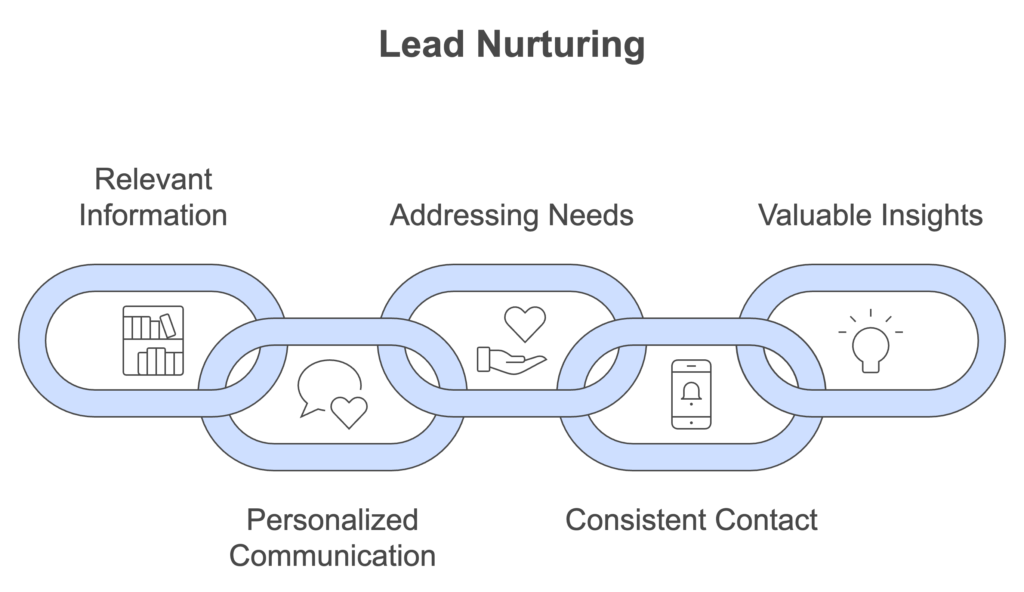
To keep the lead engaged, lead nurturing is not a random process. The well-executed lead nurturing has these features:
- well-timed
- strategic
- relevant
- automated
- consistent
- focused on long-term success, like customer loyalty, retention, and ROI.
Understanding Lead Nurturing: The Best Practices
Contrary to lead generation, lead nurturing doesn’t focus on generating new contacts.
Lead nurturing focuses on converting leads already scored well within your marketing and/or sales lead databases.
Essentially, lead nurturing is a series of strategically tailored communications where each step has a clear goal for your desired action.
You must have already done lead scoring to start nurturing the right leads. Lead scoring assigns numerical scores to your leads to prioritize them accordingly.
Nurtured leads produce a 20% increase in sales opportunities versus non-nurtured leads (Demand Gen Report).
So, to have more sales opportunities ready in your sales pipeline, you have to nurture leads.
6 best lead nurturing practices are:
1. Segment your leads.
Lead segmentation is the process of dividing potential customers into distinct groups based on shared characteristics, such as demographic data, industry, behavior, or purchasing patterns.
For example, in lemlist, you can filter your contacts according to their company, lifecycle, and job title or set your own custom fields.
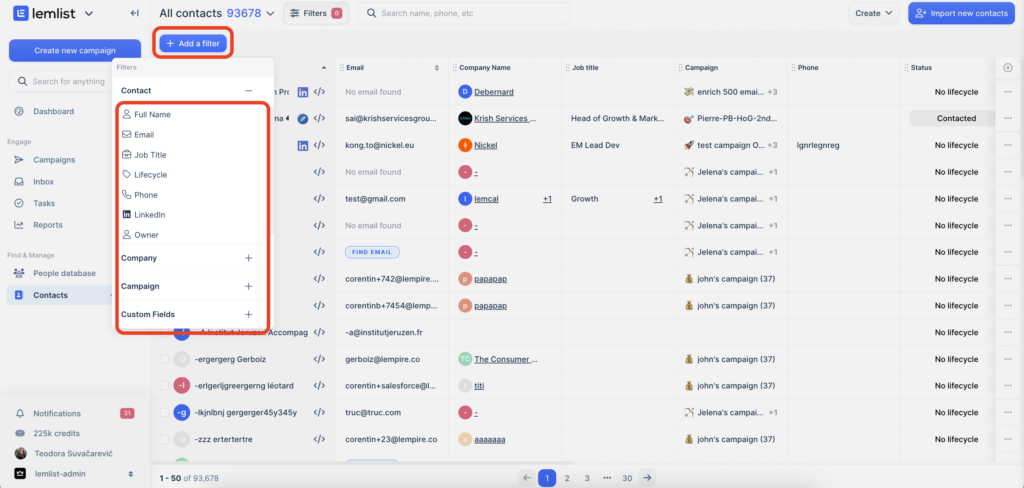
This technique allows businesses to tailor their marketing strategies and communication to address each segment or group’s specific needs and interests.
As a result, segmentation leads to more personalized interactions that hugely increase customer engagement.
2. Nurture during critical moments.
During the buying cycle, there are two optimal moments to collect information about contact: when they first interact with your business and when they decide to purchase from you.
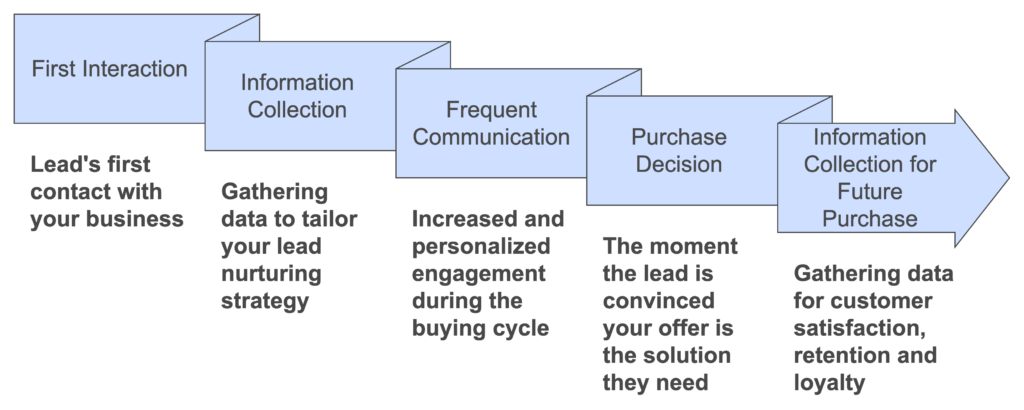
It’s smart to communicate with your contacts more frequently during these touch points.
3. Personalize your message.
Lead nurturing is by definition a customer-focused procedure. That’s why you want to personalize every engagement you have with them.
Calling a customer by name or mentioning their business is, of course, not enough. But crafting fully custom messages requires tons of manual work and extra hours.
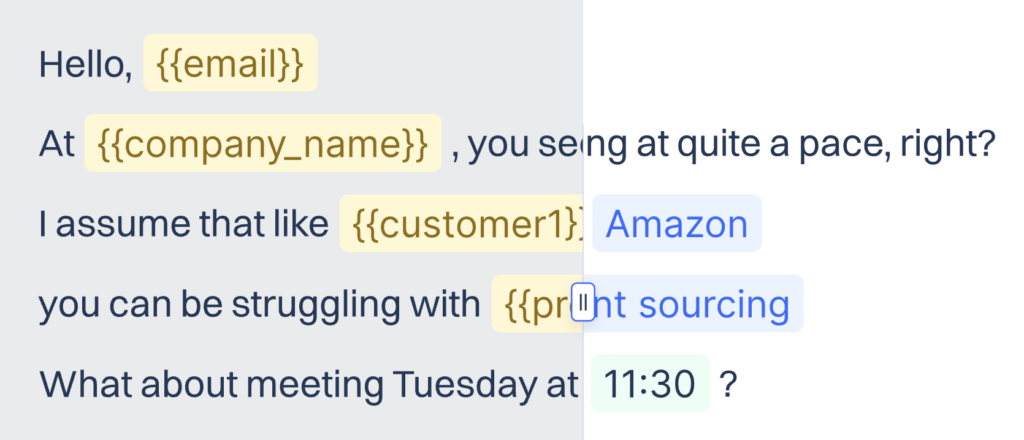
Now, imagine how inefficient personalizing your communication becomes when you need to send not one lead-nurturing email but thousands.
You can use lemlist, a sales engagement platform that excels in strategic personalization by offering:
- custom text variables to make your message valuable and engaging to your leads,
- personalized images with your leads’ names, logos, and screenshots to make the communication unique and authentic,
- custom videos to stand out in your leads’ inbox,
- dynamic landing page where you can include CTAs, calendar, and any asset,
- liquid syntax to adapt the message to your leads’ interests,
- AI-powered multichannel campaigns that make your lead nurturing ultra-targeted.
4. Adopt progressive profiling.
Progressive profiling is when you fill in gaps in contact records by asking prospects to fill in additional info via the system.
Contacts are much more likely to share information about themselves during the first 30 days they’re engaged with you. That’s why you need to start gathering and actively asking to submit info about themselves early in their journey.
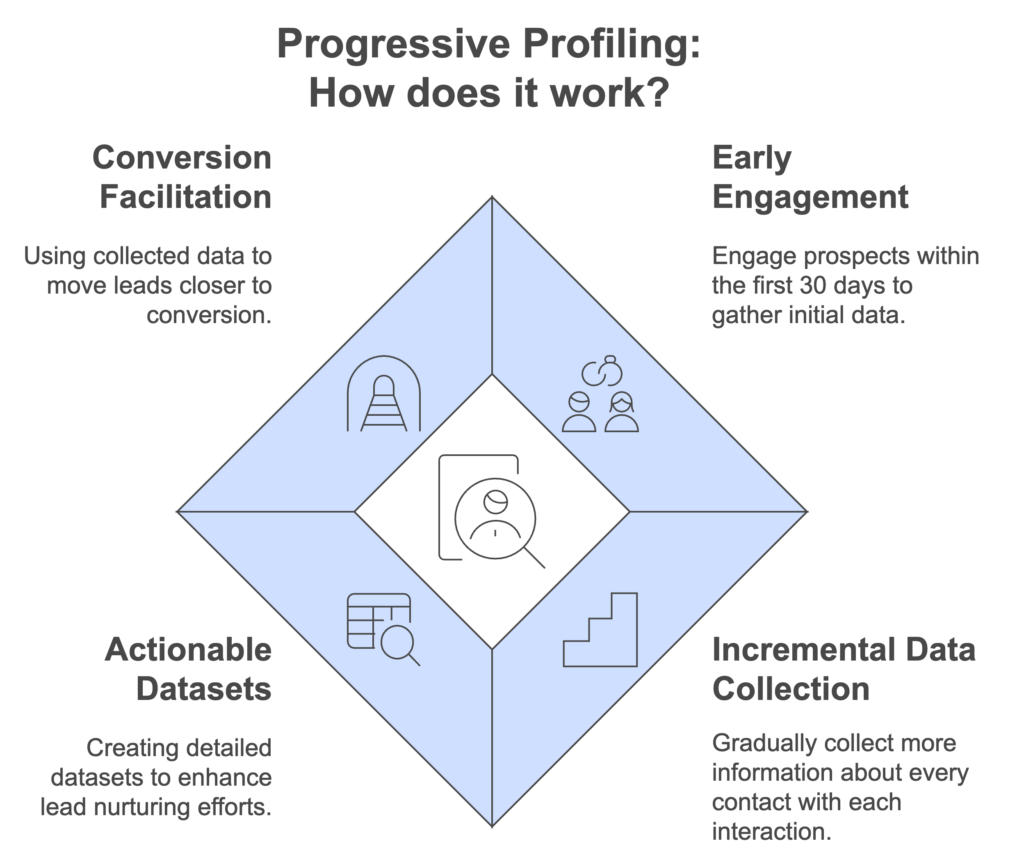
Essentially, each time a potential buyer clicks on the offer or link, they are asked to provide a little bit more details about themselves, their interest areas, or their business goals.
This lead nurturing tactic helps businesses create even more actionable and in-depth datasets on each lead contact.
This information is incredibly valuable when lead nurturing because it brings the lead closer to conversion.
5. Nurture your customers.
Acquiring a new customer can cost 5 to 7 times more than retaining an old one.
That’s why you want to take care of your customers even after you close the deal.
Customer nurturing is one step after lead nurturing. It’s the process that builds long-term relationships with existing customers.
Customer nurturing must be based on your customers’ self-directed journey, that’s why you need keep your customers active in your sales pipeline even after they convert.
This opens up new sales opportunities like higher tier plan subscriptions, extra feature purchases, custom packages for scaling up, and so on.
You must have a clear view of existing customers to ensure you nurture your paying customers. Think about:
- Are they genuinely satisfied with the service you provide?
- What problems are your customers facing right now?
- What new solutions do they need?
- Do they want to improve their workflows, and how can you help them achieve their goals?
- What new product features would they benefit from?
- What new pricing plans and feature sets can you offer them if they’re in a scale-up stage?
Knowing the answers to these questions is key to businesses’ long-term success.
6. Set clear objectives to measure.
Make sure you set measurable objectives for your lead and customer nurturing to demonstrate changes in your ROI.
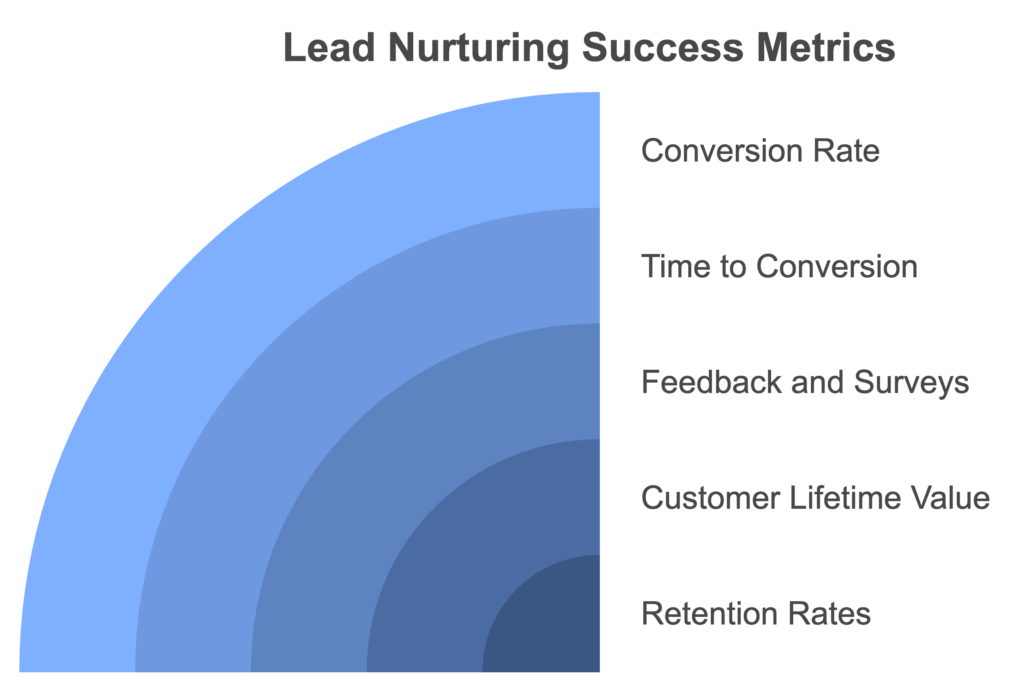
To determine the success of your lead nurturing efforts and their impact on your return on investment (ROI), you can measure several key objectives:
- Conversion rate: Track how many leads move through each stage of the sales funnel and ultimately convert into paying customers. An increase in conversion rate can indicate effective lead nurturing.
- Engagement metrics: Measure the level of interaction with your emails, social media posts, and other communications. High open rates, click-through rates, and interaction times suggest your content resonates with the audience.
- Lead scoring changes: Observe changes in lead scoring, which quantifies how leads interact with your marketing. Increases in scores can imply successful nurturing as leads engage more deeply with your offerings.
- Time to conversion: Analyze the average time it takes a lead to become a customer. Shorter times may suggest more effective nurturing by providing timely, relevant content that accelerates decision-making.
- Customer Lifetime Value (CLV): Examine whether nurtured leads tend to purchase more frequently or opt for higher-value products, indicating higher CLV.
- Feedback and surveys: Use direct feedback from customers to gauge how nurturing has influenced their perception and decision-making.
- Retention rates: Look at whether nurtured customers tend to stick with your brand longer than those not nurtured. High retention rates can point to successful nurturing and positive customer relations.
Lead Nurturing Tactics: Low touch vs High touch
Low-touch lead nurturing is a less personalized and more automated way of contacting potential customers.
The low-touch tactic is typically used for leads who have either shown lower levels of interest or have less potential for high revenue.
The goal here is to maintain engagement and provide value with minimal time and resource investment.
The most common examples in low-touch lead nurturing are:
- Automated email campaigns: Sending out monthly newsletters to all its leads to keep them informed about new products, services, or content.
- Educational webinars and podcasts: Hosting webinars on topics that interest a broader scope of potential buyers without intense customization. As an example, a tech company can host a webinar on artificial intelligence, which is relevant to all its leads regardless of their current engagement level.
- Social media updates: Regular posts on company achievements, products, or general industry news. This type of lead nurturing content doesn’t push for conversions but keeps leads in the loop by providing valuable info.
High-touch lead nurturing is highly personalized and direct interactions aimed at leads who show a high level of interest and significant revenue potential.
This lead nurturing strategy requires more resources and time but is aimed at converting top-tier leads into customers.
The most effective lead nurturing strategies include segmenting leads for targeted marketing, engaging with leads during critical moments, and using progressive profiling to gather more detailed information about potential customers.
The most common examples in high-touch lead nurturing are:
- Personalized emails: Custom emails that address the specific needs or interests of the lead, mentioning details about their company or industry struggles. For example, a software salesperson sends a detailed analysis to a potential client showing how their current sales processes can be optimized using the software, highlighting past success stories with similar companies.
- Personalized demos and customized trials: Providing leads with highly customized demonstrations or trial runs of the product tailored to their specific use case. For example, you can set up a tailored demo environment for a potential customer, allowing them to see firsthand how the software integrates with their existing systems and improves efficiency.
- One-on-one calls or in-person meetings: Direct interaction via phone calls or in-person meetings to discuss the lead’s specific needs and how the service/product can help.
Low-Touch vs High-Touch Nurturing: Main differences
High-touch strategies are highly personalized; low-touch strategies are more general and automated.
High touch requires more resources and time, focusing on fewer high-value leads; low touch is less resource-intensive, targeting a larger group with less engagement.
In high-touch, communication is more frequent and direct; in low-touch, it’s less frequent and often done through broad channels like email newsletters or social media.
High-touch aims to convert high-potential leads into sales quickly; low-touch aims to gradually build interest and keep the brand in mind for future decision-making.
| Low-touch Lead Nurturing | High-touch Lead Nurturing | |
| Resources | Requires little | Requires a lot |
| Focus | Broader groups | High-value leads |
| Goal | Build interest | Quick conversion |
| Communication | Occasional | Frequent and direct |
| Impact | Gradual | Immediate |
4 Stages for Lead Nurturing Process
1 Stage: Awareness
The leads haven’t entered your sales funnel yet, so you reach out to them yourself. This can be done with outreach campaigns to get new outbound leads or by sharing valuable content on your blog site that attracts inbound leads.
At the awareness stage, sales reps don’t work by themselves, but they collaborate with marketing and growth teams in:
- publishing posts on social media channels,
- creating blog articles about relevant topics,
- running ad campaigns to draw leads to your website,
- sending out newsletters and direct emails with valuable offers,
- creating a knowledge base that educates the lead and motivates them to learn more about your product or service.
Before the lead is ready to consider your service as a potential solution to their problem, they will go through various touchpoints in the awareness stage. These touchpoints can include:
- e-books,
- podcasts,
- masterclasses,
- ads,
- pop-up forms,
- first encounters with the sales rep.
2 Stage: Interest
Your lead advances in your sales funnel as soon as they show an initiative to learn more about your solution.
At the interest stage, you must prepare clear communication, active interaction, and comprehensive calls to action with your offer. There can be many lead nurturing activities at the interest stage, including:
- company conferences and webinars,
- discovery calls,
- downloadable content like audio guides, case studies, templates
At this lead nurturing stage, your goal is to make the lead aware of your offering and how they’d benefit from it.
3 Stage: Consideration
As soon as the lead realizes your solution is the one they need, they progress further down the sales funnel. It’s time to be more specific about the actual product or service features, benefits, and how your solution compares to competitors.
The consideration stage is typically handled by sales reps. Lead distribution is crucial at this stage because it makes sure that each lead is assigned to the most suitable sales rep.
If you want to boost the process and make it easier, we recommend automating the process with lead distribution software.
The personalized demo that shows how your product or service solves a lead’s problem typically works very well in nurturing leads further down toward conversion.
4 Stage: Evaluation
The lead nurturing process of evaluation marks the point at which your lead starts considering buying your product or service.
Nurturing leads at the evaluation stage, your goal is to:
- create a sense of urgency,
- show how and why your product is the best solution to the leads’ problems,
- show what exactly the lead can expect from your product,
- differentiate yourself from the competitors.
Since the lead is most likely evaluating other options and alternatives, taking into account the pros and cons, as well as the pricing and packages, it’s crucial to show how your solution is better than others.
You must prepare your USP strategy and communicate it clearly, but that alone is not enough.
To differentiate your solution from competitors, offer:
- free trial,
- free consultation,
- an in-depth, personalized demo with real-life scenarios that are relevant to the lead,
- customer success stories and examples.
9 Best Lead Nurturing Tools
Lead nurturing tools are key in bringing you better results from your lead nurturing.
First, they increase efficiency by automating repetitive tasks like sending follow-up emails and scoring leads, allowing your sales reps to focus on more important tasks.
Secondly, they enhance personalization by using data to tailor communications to individual leads’ behaviors and preferences.
Lastly, by delivering relevant content and timely communications, lead nurturing tools make converting leads into paying customers easier.
These are the nine best lead nurturing tools to use in 2025:
| Tool | Best for | Pro | Con | Rating ⭐⭐⭐⭐⭐ |
| Pipedrive | CRM features | Smart filters for targeted nurturing | No separation between leads and contacts | 4.3 |
| Monday.com | Small teams who need a simple tool | Lead scoring based on criteria | It’s primarily a project management tool | 4.6 |
| EngageBay | Acquire and engage new customers | Custom fields and filters for lead segmentation | Limited email templates | 4.6 |
| HubSpot | Centralized platform for managing all your lead data | Automated lead nurturing workflows | Steep learning curve and high investment | 4.4 |
| LeadSquared | Design prospect journey workflows | Drag and drop automations | Limited reports and bugs | 4.4 |
| Zixflow | Small teams with a solid budget | Set up sales cadences | Not a well-established tool | 4.9 |
| Pipeline CRM | Managing leads in your CRM | Sales pipeline management capabilities | Feature sets are limited | 4.4 |
| Ortto | Enterprises that can spend more than on average | Targeting based on lead behavior | Very expensive | 4.4 |
| lemlist | Sales teams who need a reliable platform to make more conversions | Robust feature set for all lead-related activities and automations | Not a designated lead nurturing tool | 4.5 |
Key Takeaways
Only 4% of website visitors are initially ready to make a purchase. That’s why businesses want to engage with the majority who are still in the early stages of their buying journey.
Lead nurturing is essential in this process because it builds relationships through tailored content and personalized communication to educate and earn the trust of potential customers.
The goal of lead nurturing is to warm up your leads and bring them closer to conversion.

